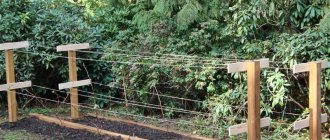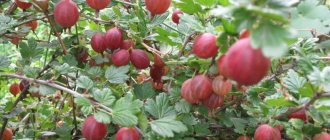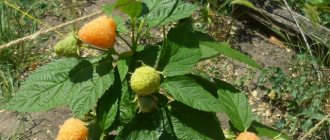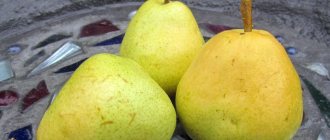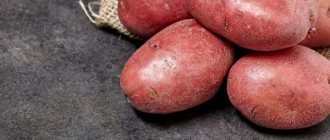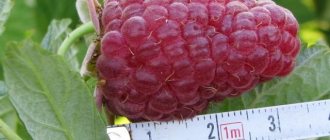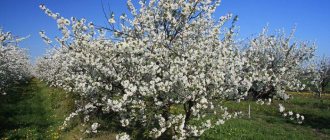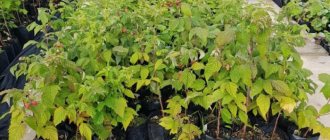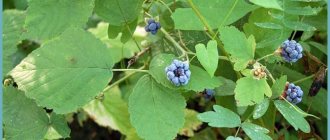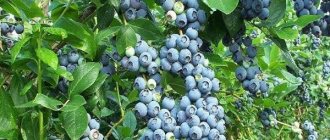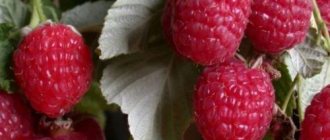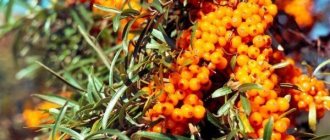Varieties of remontant raspberries
According to gardeners, remontant raspberries are the best representative of the genus : the harvest can be harvested several times a season, the berries are large, and fruiting is abundant. I just want to replace all traditional varieties with remontant ones and enjoy delicious, aromatic berries all summer long.
Let's consider varieties of remontant raspberries of early, medium and late ripening.
With proper care, these varieties bear fruit almost continuously.
Repairers
The key feature of remontant raspberries is the ability to produce several harvests per year. As a rule, this quality is relevant only for the middle zone or the south, where there are warm, early summers and long autumns.
Remontant raspberries can also be grown in the north, but they turn into ordinary varieties, giving no more than one harvest per season.
Features of caring for remontant varieties are in our article.
Reliable
For gardening - almost ideal raspberries.
Firstly, ripe raspberries do not fall from the bushes for up to 2 weeks.
Secondly, the berries have a sweet, bright taste.
The variety bears fruit from mid-summer, and under favorable conditions produces berries until the first frost, until November.
Monomakh's hat
A very productive variety that produces up to 6 kg of fruit per bush. Some fruits even reach 20 grams. weight. “Monomakh's Cap” is a variety with an autumn harvest that is more abundant than the summer one. Therefore, it is much preferable to grow such raspberries in a temperate climate.
Daughter of Hercules
A variety bred from the famous “Hercules”.
Its main qualities are abundant fruiting from mid-summer, the ability to harvest until late autumn, incredibly large berries (from 10 to 20 grams).
Early varieties: description, photos, reviews
Thanks to the early ripening of berries, raspberry varieties have gained universal popularity.
Bryansk miracle
In 2001, I.V. Kazakova and S.N. Evdokimenko began breeding the variety. For five years, breeders studied the characteristics of the Bryanskoye Divo variety, and it went on sale in 2006.
Bryansk miracle Raspberries are high-yielding, the harvest from one bush is 3.5 kg. On average, the berries weigh 7 g, but there are also impressive specimens weighing up to 11 g. The fruits are elongated, large, and red in color.
The taste is sweet with a pleasant sourness. The variety is suitable for industrial cultivation: during long-term transportation, the fruits remain fresh and do not lose their shape and do not cake. The second time it begins to bear fruit in mid-August. The timing of fruiting depends on the location of zoning. The harvest can be harvested before frost.
The ripening of berries occurs from top to bottom, so you can cut off the lower flowers so as not to waste the plant’s strength on their setting and growth. In this case, the top berries will be larger and ripen faster.
What will gardeners say?
The variety does not require garter, since the shoots themselves are powerful and the bush is compact, however, in strong gusts of wind the shoots can lie on the ground.
Delicate variety, picky about the planting site. Prefers light, fertile soil.
By the end of the growing season, it drops its leaves and does not look very good; the berries ripen on shoots devoid of foliage. However, this characteristic does not affect the taste of the berries and yield.
Hercules
The variety causes a lot of controversy among amateurs and professionals. Some people like the high yield and size, while others are not happy with the taste of the berries.
Hercules Advantages of the variety:
- The harvest is harvested 2 times per season: mid-June and August-September.
- Can be grown in Belarus, the Central and Central Black Earth regions, central Russia, Polesie.
- Poor formation of shoots does not require constant destruction of the shoots.
However, the weak formation of shoots does not allow the “Hercules” variety to be quickly propagated. By autumn, strong shoots become purple-red, hard thorns are located over the entire surface, wrinkled leaves are slightly curled downwards.
Truncated conical fruits weigh 4-10 g, rich, ruby-red color, uniform drupe. Productivity – up to 2.5 kg per bush. It is not susceptible to diseases such as gray rot and is resistant to raspberry mites.
The variety is difficult to tolerate winters with little snow, so it requires pruning in the fall and shelter.
Zyugan
Zyugana The variety is suitable for industrial cultivation: good taste of berries and high transportability . High performance is achieved when grown in partial shade.
The shiny, rounded, elongated fruits weigh up to 6 g, and when ripe they are intensely red. The dense drupe prevents the berries from scattering when picked. The variety is resistant to hot sun, the fruits do not bake.
Reviews from gardeners
To get a good harvest, you need to grow on fertile soils, add organic matter and humus. "Zyugana" is resistant to frost. Berries ripen together on powerful, thornless shoots. From one bush you can collect up to 8 kg.
However, it requires support. All early varieties are good in themselves, but when choosing, you should take into account climatic conditions so that the bushes have enough heat and humidity, otherwise the yield will be significantly reduced.
Remontant raspberry varieties for 2021
Raspberry Pokhvalinka
The bush is powerful, with many shoots, height 30-150, with good watering up to 80cm. The root system is very powerful. The fruits are fleshy, large and very large, especially the first harvest, max up to 20g. Berries have a dessert sweet taste with slight sourness, with a strong raspberry flavor and aroma. Well transported.
Raspberry Ridge
The bush is of medium vigor, very spreading, 100-150 cm. The berry is large and very large, with elastic, dense, but dense pulp, weight up to 14 g. The skin is thin, but strong, resistant to damage. The berries are beautiful, rich ruby color with shine and a whitish coating. The taste is very sweet, with a strong raspberry aroma. Fruit detachment is dry. Transportability is very good.
Nugget
The bush is medium-sized, but individual stems reach a height of 200 cm. The entire bush does not need a garter. The berry weighs up to 13 g. The drupes are small. The harvest ripens from late July until frost. The variety produces little shoots, tolerates drought well, and is frost-resistant.
Raspberry Eurasia
A small upright bush up to 140 cm high. The variety is unpretentious to soil and climate. Berry weight 4.5g, max 6.5g. The berries are dense and separate well from the stem. The harvest can hang on the bush for 7 days without losing quality. The variety is very transportable. The taste is sweet with sourness, the aroma is weak. The yield is very good. The variety is resistant to almost all diseases and pests.
Nizhny Novgorod
The bush is very spreading, 150-180 cm high. The weight of the berries is on average 6 g, maximum 12 g. The taste is sweet with a slight sourness. Fruiting from late July to late autumn. The harvest does not fall off for a long time, even when fully ripe. Transportability is very good. The variety is unpretentious to growing conditions.
Yellow giant
Harvest - 6 kilograms per plant. The fruits do not fall off and tolerate transportation well. The height of the plant exceeds 2 meters, and is used in the decoration of gazebos and alleys. The giant is frost-resistant and resistant to sores. A good choice for people with allergies and small children. The yellow giant does not cause allergic reactions.
Bryansk miracle
Ripens in mid-August, harvesting continues until frost. Divo has a bright red color and an elongated conical shape, with an average weight of 6 -11 grams. Harvesting from a bush is 4 kg. The fruits are sweet and sour.
- the plant loves sunny areas and does not tolerate waterlogging of the soil, its roots rot;
- needs loose soil, regular fertilizing with humus or manure;
- in July, add 0.5 liters of ash under each bush to increase productivity;
- To enlarge the berries, the lower branches with buds should be removed before flowering.
Plants with mid-ripening berries
They are characterized by abundant fruiting and resistance to unfavorable conditions and diseases. The berries are large. Sweet, aromatic.
Atlant
Having learned about the new variety, everyone was chasing Atlant raspberries . How reasonable are gardeners' expectations? Let's try to consider the characteristics of the variety.
Atlant Berries are bright red, weighing 7 g. Up to 15 kg of fruit can be collected from one mother plant per season. Good yield, isn't it?
The variety can be grown throughout Russia, Belarus, and Ukraine. If you look at the plantings while the berries are ripening, you may not immediately believe your eyes, because all the fruits will have the same shape and only slightly differ in size. The homogeneous drupe prevents damage to the structure of the berries during picking.
Erect shoots reach a height of 1.6 m, young branches are pubescent. It produces shoots, so it reproduces easily. Cuttings take root well in water.
The Atlant variety needs abundant watering. If this condition is neglected, the berries will become small and the yield will decrease. Therefore, it is necessary to inspect the plantings daily and water them on time.
Reviews from amateur gardeners
The variety is suitable not only for amateur cultivation; it can be sold on the market and sold in hypermarkets. The keeping quality of the berries is excellent.
It is recommended to feed with organic fertilizers.
Caramel remontant mid-season
A young remontant variety, bred by breeders in 2013 . Half-meter stems grow vertically, the bush is erect. Dense shoots, so the variety does not need tying.
Caramel remontant mid-season The shoots have thorns, but they are insignificant, which does not make harvesting difficult. Oval leaves of a typical shape with a slight elongation towards the edge. There are teeth along the edges.
Berries with a rich taste, aromatic, large. They weigh 15 g. When harvested, the pulp is not damaged and does not lose its elasticity. The fruits are red in color, can be stored for a long time, and therefore are characterized by good transportability.
Reviews from gardeners
In good conditions, a lot of root growth is formed, which makes it difficult for gardeners to maintain planting boundaries. It can fill the entire area.
It is recommended to remove excess growth while weeding the area allocated for raspberries.
Orange miracle
Compact, medium-sized plant with shoot heights up to 1.8 m . The erect stems are completely covered with thorns. When growing, it is recommended to install a trellis, since under the weight of the berries the shoots bend to the ground and can break.
Orange miracle One-dimensional orange berries of large size. On average they weigh 5 g. Sometimes you can see large, velvety fruits, elongated, weighing up to 12 g.
These are real giants! Remontant variety. Harvesting - 2 times per season. The taste of berries depends on climatic conditions. The warmer the weather, the more sugar content the fruits have. If it rains constantly, the berries acquire a sweet and sour taste.
Gardeners give only positive assessments to this variety. Attracted by the exotic color of the fruit and extraordinary taste.
It is better to grow in a sunny place so that the berries are sweet.
Penguin
A variety of domestic selection, bred in 2006. Suitable for amateur gardening, less commonly grown for industrial purposes.
Penguin The advantages of the standard variety are much greater than the disadvantages. Miniature bushes are strewn with berries from top to bottom, like a Christmas tree with balls. With low growth, productivity is high - 2.5 kg of fruits per plant.
Fruiting begins in the last ten days of July and continues until mid-August. On powerful, strong shoots with short internodes, the thorns are located only at the bottom. Most often grown as an annual crop.
What do gardeners say?
The standard plant attracts with its decorative effect, especially during the fruiting period. Large berries peek out from under the thick crown.
The round fruits weigh 5 g, do not crumble when picked, and taste sweet-sour and pleasant.
Taste qualities largely depend on the growing region and soil composition. Sandy and clayey soils affect the sugar content of fruits.
This also happens when the soil is over-moistened. In hot summer, the fruits are sweet, without sourness.
Polana
A high-yielding and early-fruiting variety of Polish selection, it was released in 1991. The berry crop has perfectly adapted to our climate, so it can be grown everywhere.
Polana The bushes are powerful, the variety produces many root shoots. The height of the shoots is 160 cm. They grow vertically and have thorns over the entire surface.
Thanks to strong branching, you can reap a good harvest. Dark raspberry berries weigh up to 7 g, the drupes are small, the pulp is juicy and dense.
Features of growing the variety: what gardeners warn about:
- the plant is moisture-loving, requires constant watering, especially in dry times
- In autumn it needs fertilizing with organic fertilizers.
- to make harvesting easier, shoots should be tied to a support
- Before the ovary forms, it is necessary to spray with insectofungicides.
You need to monitor the condition of the soil, constantly weed and loosen, especially after rains.
Tarusa
Summer raspberries with powerful, erect stems. People call it the raspberry tree, as it is a standard plant. The variety appeared in 1987.
Tarusa Thick, woody stems have no thorns. Plant height is 1.5 meters. Raspberries give a good harvest; under the weight of the fruit, the stems bend down.
The yield is high; up to 4 kg of berries can be harvested from one bush. The first collection is in early July, the second in August. Growing in the southern regions extends the fruiting period.
Reviews from gardeners
Due to the heaviness of the berries, raspberries have to be tied to a trellis. Bright red berries with small drupes weigh 7 g. The fruits are not always the same shape and can be found curved.
The berries are suitable for canning and fresh consumption.
Monomakh's hat
Monomakh's Cap A miniature variety with powerful shoots, up to one and a half meters high. The fruits are large, deep red, weighing up to 7 g. 4 kg of berries can be harvested from one bush per season.
The fruits are blunt-conical, elongated in shape. The berries are tasty, sweet, with barely noticeable sourness. Thorns are located only at the bottom of the stems.
Fruits from mid-July until the first frost. The stalks easily give off the berries.
Advantages of the variety:
- high resistance to pests and diseases
- frost resistance
- berries of the 2nd harvest are clean, without pests
- easily propagated by cuttings
Reviews about the variety
Prefers illuminated places, does not develop well in partial shade. In winter, it is necessary to monitor the condition of the soil in the rows between plantings to prevent the formation of an ice crust.
The presented varieties of medium ripening are fully adapted to our conditions.
Even severe frosts are tolerated with ease. However, it is required to follow agrotechnical growing practices.
Home > Publications
RASPBERRY: remontant varieties
07.12.2019
The latest generation of these varieties is changing our understanding of raspberries. The newest remontant varieties taste no worse than traditional varieties. The widely advertised Caramel is truly delicious. But most gardeners do not know that there are remontant varieties that are in no way inferior in taste to this variety: Izobilnaya Kazakova, Himbo Top, Joan Jay, Jacqueline .
Perhaps the most important problem for remontant raspberries is that they can thrive in the warm conditions of late summer and early autumn. In areas where there is not enough heat, there are simple ways to partially correct this situation. All simple techniques for ensuring proper conditions are described in detail in specialized literature.
The main advantage of remontant raspberries is practically ecological fruiting. Remontant raspberries are virtually free of pests and diseases, which means they do not need to be treated with chemicals. The berries are the purest!
Many varieties of remontant raspberries are weak-growing, have a strong stem and can be grown without additional support: Penguin, Atlant, Eurasia, Himbo Top, Autumn Treche and others.
Winter hardiness. Experienced gardeners remember that in past harsh winters, raspberry shoots often froze and there was no harvest. Since remontant raspberries bear fruit on annual growth, there is no problem of winter hardiness for them.
Well, one more thing: having remontant raspberries, you can manage to get both a summer harvest on the branches of last year, and an autumn harvest on the shoots of the current year. True, without good care this will not work.
Variety Atlant - a hard worker variety
HOW TO CHOOSE A REPAIR RASPBERRY VARIETY FOR YOUR PLANT?
Remontant raspberries, one might say, are a novelty on the plots of amateur gardeners. Gardeners are full of both supporters and ardent opponents of remontant raspberries. Why? Firstly, once again let's draw the attention of gardeners to what features distinguish them from ordinary raspberries. First of all, this is the ability to bear fruit twice a season. Once - at the usual time, on the shoots of last year, in mid-July, and a second time - on the shoots of the current year, starting in August for the earliest varieties and ending in October, when autumn frosts kill the ovary. “So what,” you say, “we already know this... And at the same time we know that the “normal” July berry is tastier than the autumn one.” Yes, that's almost true! But believe me, you don’t have enough grounds for such categorical judgments. You haven’t tasted the best varieties of remontant raspberries! We will tell you what varieties these are a little later. In order to understand that remontant raspberries are the berry of the future, it is necessary to briefly explain what disadvantages ordinary raspberry varieties have.
Orange Miracle
1. First and probably most important. Summer residents who have traditional varieties of raspberries on their property have developed an instinct: before you put even one berry in your mouth, you need to look at it carefully to see if there is a small white larva in it - the raspberry beetle. And in most cases, when caring for ordinary raspberries, you cannot do without chemical treatments. Have you ever asked yourself why the raspberries on the market are not damaged by the raspberry beetle? That's right, precisely because it is treated with anti-raspberry beetle agents! And some of this chemistry inevitably ends up in the berries. We are not inclined to aggravate this problem, we only want to draw the attention of gardeners to the importance of understanding that there are environmentally friendly products, which include remontant raspberries. And the raspberry beetle is everywhere there are raspberries!
For remontant raspberries, this problem does not exist. All the berries are clean, because the development cycle of the raspberry beetle is designed for berries that ripen in July, which means that remontant raspberries, even theoretically, are not damaged by this pest, and there is no need to spray them.
2. Since traditional raspberry varieties bear fruit on last year’s shoots, the gardener needs to provide them with a good overwintering, and many varieties (flower buds on the shoots) cannot withstand even –30 °C. This means that damaged buds do not produce a harvest, and this happens quite often.
Remontant raspberries are cut at soil level in late autumn. Only the rhizome overwinters, which never freezes.
3. In addition, long shoots of traditional raspberries need to be secured somehow - on a trellis or tied to another support. And these are additional hassles that we try to avoid. Several varieties of remontant raspberries hold the harvest load well and do not require support at all: Penguin, Atlas, Yellow Penguin, Eurasia, King Penguin .
4. And to top it all off, traditional raspberries have quite dangerous diseases and pests that damage the shoots. The plant weakens, sometimes dies, and in all these cases chemicals are used, and it inevitably gets on the berries. But remontant raspberries do not have such problems. The life cycle of diseases and pests is closely related to the shoots, which also live for two years, while in remontant raspberries they are annual.
Remontant raspberries bear fruit on the current year's shoots, which are pruned in late autumn, so there are no problems associated with diseases at all!
5. Skeptics will probably note that the taste of remontant raspberries is worse than regular ones. At the same time, the fact that the main raspberry crop is used for processing is hushed up, and sugar is added there to taste.
Have you tried the taste of raspberries of the varieties Orange Miracle, Himbo-Top, Joan Jay, Izobilnaya Kazakova, Caramelka, Autumn Beauty ? They are arguably tastier than many traditional varieties!
Abundant Kazakova
6. Another complaint about remontant varieties: they ripen late and in many northeastern regions of the country, where summers are short and cool, they simply do not have time to ripen.
It is necessary to clarify that there are remontant varieties that begin to ripen very early and can fit even into a short summer: Penguin, Eurasia, Yellow Penguin .
7. But experienced gardeners manage to get a harvest even in completely hopeless climatic conditions. Some recommendations will undoubtedly come in handy here. First: we do not lose sight of and use exclusively simple “agricultural techniques” aimed at accelerating the regrowth of shoots and consisting in clearing snow in the spring from the ridge where remontant raspberries grow, and then covering this ridge with white non-woven material until flowering. These two techniques allow you to speed up the start of fruiting by almost a month or more and get ahead of the fall! These two agricultural methods make it possible to obtain berries in regions with a harsh climate, such as Arkhangelsk or Khanty-Mansiysk.
Well, last tips:
Don't try to get two harvests. Do not allow shoots to thicken in the bush; leave 4–5 of the most powerful shoots per square meter of area; remove the rest, less developed ones, in early June at soil level. And you are guaranteed an early harvest.
PENGUIN
A beautiful variety, excellent harvest, large clean berries. But it’s not very tasty. Yes it is! It is the residents of the center of Russia who can dare to criticize this handsome man. Despite this, Penguin is the earliest variety; it ripens at the end of July. But in the North, somewhere in Tyumen or Krasnoyarsk, he has no one to compete with. Other varieties do not ripen at all. And if you consider that in winter it never freezes out, then it should be called “Northern Penguin”. Penguin is a real find for gardeners in the northern regions who are trying to grow berry crops in areas with a harsh climate.
ATLANT
A hard worker variety that can serve as the basis for small commercial production. A beautiful, tasty berry, and also dense, ideally suited for sale on the market. 20 bushes with good care can provide a harvest of 100–120 kg in August-September. And if you add that the bush is erect and does not require support, then this is truly a godsend for large-scale commercial production.
ORANGE MIRACLE
Holiday variety. The combination of excellent taste, raspberry aroma and amazing amber color makes it unique among many remontant varieties. Several bushes of this variety will be both a decoration and a delight for your garden.
HERCULES
One of the first successful varieties of remontant raspberries bred by I.V. Kazakov. Feels good in various soil and climatic conditions. The bush is of medium vigor and requires support. High-yielding technical variety. The berries are large, wide-conical, dark red, quite dense. The taste is table, slightly sour. The variety is characterized by reliable fruiting even with poor agricultural technology.
FIREBIRD
Refers to vigorous varieties, which have a common disadvantage for such plants: support is required, since the shoots lie down under the weight of the harvest. The bush itself is represented by strong, well-branched, drooping shoots, which are colored with ripening chiseled red berries against the background of light green foliage. The berries are quite large, bright red, elongated, very beautiful and tasty. The ripening period for the variety is at the end of August - beginning of September. The conditions of the Lipetsk and Voronezh regions are better suited to unlocking the full potential of its productivity.
YELLOW PENGUIN
Many gardeners are already familiar with the remontant variety Penguin, they know it as the earliest and most productive variety, and this is true. And so nature gave a twin variety, very similar to Penguin in terms of growth strength and ripening time, but with yellow berries, round and slightly sweeter than those of the original variety.
ABUNDANT KAZAKOVA
A random seedling, obtained in an experimental breeding nursery from the original variety Bryanskoe Divo. A variety of medium vigor, with drooping shoots, requires high-quality support, since under the weight of a large harvest, shoots with ripening berries lie on the ground and the berries can rot. The yield is very high, surpassing any other variety in terms of this indicator. With good care, it is possible to collect a bucket from a bush. The beginning of ripening of berries is the end of August. The berries are medium-sized, elongated, chiseled, very tasty, the taste is not inferior to the Caramel variety, the most delicious variety in the collection of varieties studied in the experimental breeding nursery.
BRYANSK MIRACLE
The pride of Russian breeders. The variety was bred by Ivan Vasilyevich Kazakov. Surprisingly large conical berries, excellent taste and high yield are the hallmark of the variety. The variety is vigorous, with drooping shoots and requires support. The berries ripen at the end of August. In general, the variety is well suited to the conditions of the center of Russia.
YANTARNAYA SADKO
Mid-late remontant variety. It is distinguished by apricot-colored fruits and a delicate taste. The beginning of ripening is mid-August. The bushes are powerful, spreading, and require support. The fruits are bright orange, spherical, with juicy pulp. The taste is sweet, with a slight sourness, practically without aroma. The weight of one berry can reach 3.5 g. The taste is somewhat inferior to the Orange Miracle variety. The Yantarnaya Sadko variety overwinters well and is weakly affected by pests and diseases. Does not tolerate drought well. To get a good harvest, regular watering is necessary.
EURASIA
A variety with vertically growing shoots, can be grown without support. It has a characteristic shape, reminiscent of a small tree, where medium-sized red berries, quite tasty, ripen on the side branches. Mass ripening – mid-August. By mid-September the variety finishes bearing fruit.
RHINOCEROS
A variety of red raspberries, distinguished by the original shape of the berries: on the top of some large ripe berries, a kind of rudiment of a new berry is formed, which somewhat disrupts the perception of the variety. There are almost no thorns. Very large berries and high yields with a good agricultural background make this variety very popular. Requires support. Harvesting from the end of July until frost.
ROYAL PENGUIN
The variety was obtained in an experimental breeding nursery and has been studied since the end of August 2010. The berries are large, round, and sweet. The structure of the bush is similar to the Atlant variety with its upright habit. Can be grown without support. The beginning of ripening is mid-August.
So, you have decided which varieties you need and have made a choice, for example, in favor of remontant raspberries. In this case, we would like to introduce you to foreign new products that are worthy of attention. These are the varieties Jacqueline, Himbo Top, Joan Jay (Joan G).
JACQUELINE
An early variety of remontant raspberry, bred in 2003 in the USA. The berries are large and very large, weighing 8–9 g, elongated (up to 40 mm), beautiful in shape, dark burgundy in color. The fruits are very sweet, practically devoid of sourness, have a pronounced aroma, and a rich raspberry aftertaste. The disadvantage of this variety is uneven ripening of the berries. A not fully ripe “nose” makes it difficult to eat the berries. Frequent harvesting of only fully ripe fruits is required. Ripe berries are dense, with good transportability, and tolerate freezing well. After defrosting, they do not sour. The yield is high - more than 2 kg of berries per bush. Due to the early ripening period (early August), the crop has time to ripen completely before frost. Jacqueline is highly stable. The taste of the berries does not decrease either during prolonged rains and cold weather, or during hot dry periods.
JOAN JAY
The relatively new variety of remontant raspberry Joan Jay is famous for its large fruit, excellent taste and abundant harvests. However, the berries quickly overripe and do not tolerate transportation and long-term storage, so the variety is more suitable for growing in small quantities in private garden plots, for fresh consumption and frequent collection. Joan Jay bushes are distinguished by their short stature (on average 100–120 cm, maximum height up to 170 cm), thornlessness along the entire length of the shoot, and the strength of the branches. Approximately 5–7 (up to 10) shoots are formed on an adult plant. From one fruiting branch you can get up to 90 berries weighing 6–7 g each. The variety needs to be tied to a trellis, since the berries are large, heavy, and the branches, even with their small height, cannot withstand heavy loads.
HIMBO TOP
As soon as gardeners try the berries or see the Himbo Top raspberry bush growing, the number of fans of this variety increases. No wonder. The Himbo Top remontant raspberry has a number of features that attract garden owners. Let's get to know this interesting variety in more detail. The most attractive feature of Himbo Top is its large berries. Each berry is bright red, not prone to darkening, and can easily be separated from the stalk. The weight of the berries is from 5 to 8–10 g; the appearance of crushed berries at the final stage of fruiting is not typical for the variety. Experts note the excellent taste of the firm berries, which have a subtle but pronounced raspberry aroma. The berries are sweet, with a subtle sour taste, juicy and sugary. Himbo Top bears fruit within two months; fruiting begins in mid-July in the southern regions, and in early August in the central zone. The variety has a high yield of up to 3 kg per bush. The ability to harvest raspberries twice a year is considered a valuable quality. June is the period of fruiting of the branches of the second year of life; in August - September, berries are collected on the branches that have formed in the current year. Raspberries of this variety do not make any special demands on the soil composition and are resistant to diseases such as fungal infections, root rot, and late blight, which allows it to be planted even on old raspberry fields. All this makes Himbo Top raspberries an increasingly popular variety.
Return
Late harvest
Many gardeners are delighted with varieties with late ripening berries. And they have many advantages. Firstly, raspberries ripening in the second half of summer are clean, without pests, and secondly, the ripening time allows you to get fruits when all the plants have practically borne fruit.
Diamond
Large-fruited, but slightly capricious remontant variety . Having planted it on their plot, many gardeners cannot wait until it begins to bear fruit. And when they wait, they are... disappointed. Why is this happening?
Brilliantovaya Growing the Brilliantovaya variety requires certain knowledge of agrotechnical techniques.
For planting, you need to choose an open sunny area, otherwise the yield will be poor. It is better to propagate raspberries in the fall. During planting, the root collar should not be covered with sand.
However, in sandy soil, shallow planting can cause the plant to die . During fruiting, it requires tying to a support. One-dimensional, dark red berries weigh up to 7 g. Harvest in August until frost.
In preparation for winter, cut off the entire above-ground part. Spring pruning is not recommended.
Polka
Opened in 1993 by Polish gardeners. Soon this variety became the standard among other representatives.
Polish She is characterized by:
- good appearance of berries
- high yield
- disease resistance
The medium-sized variety produces many root shoots. The branches do not require additional support, they are dense, and do not bend when fruiting is abundant. There are few thorns, which allows you to harvest without much difficulty.
The berries look like a thimble and have a regular shape. The pulp is dense, red, moderately juicy, not watery. The sweetness of the berries is not cloying, complemented by a slight sourness. It begins to bear fruit at the end of July; harvesting continues until frost.
Thanks to its keeping quality, the variety can be transported over long distances. Suitable for freezing, good for fresh consumption, and for canning.
After defrosting, the berries do not lose their shape and taste.
Taganka
Taganka Juicy, bright red berries have a conical shape, weigh 5 g. Abundant fruiting. One bush produces up to 5 kg of berries; they are easily separated from the stalk.
The tall bush has 7-9 powerful shoots, young ones are covered with soft thorns, and old ones are covered with thorns, which makes harvesting difficult . Dark green, large foliage. The variety is frost-resistant.
Reviews about "Taganka"
For the winter, it is better to cover the plantings with agrofibre. The fruits retain their quality for several days and are suitable for transportation.
However, dry periods lead to reduced yields, so it is necessary to monitor soil moisture so that it does not dry out.
Heritage
Translated from English it means “heritage”. Yes, we inherited an ideal remontant variety. Undemanding to growing conditions, the Heritage variety has gained universal popularity among gardeners.
Heritage Bushes are powerful, compact, low. They form little root shoots. The shoots grow upward, almost vertically.
The berries are located on fruit branches that are quite strong and raised upward.
The fruits weigh 3 g, are medium in appearance, red, aromatic, dome-shaped . The fruits are easily separated from the stalk, but do not fall to the ground on their own. Medium thorniness, long stalks, high self-fertility.
The variety is prone to excessive formation of ovaries, which does not always lead to their full ripening . Therefore, during the 2nd flowering it is necessary to tear off some of the flowers.
Reviews from gardeners
It develops well in open areas and does not like gusty winds, so when planting it is necessary to take this fact into account and provide the variety with a protected place.
The plant is not demanding on soil, but grows better on fertile soils or light loam. When preparing for the winter, all shoots are cut off, even annual growth.
Varieties suitable for different regions
Raspberries are a popular crop in Russia, not only in private gardening. The Russian Federation is the world leader in harvesting this berry.
In this regard, numerous bred varieties were created, including with a focus on different climatic conditions in different regions of the vast territory of the USSR, and then Russia.
For Siberia
In Siberia, most attention is paid to the ability of raspberry varieties to withstand severe frosts in winter.
Ogonyok Siberian
Mid-season variety with medium-sized berries.
Fruits in August-September.
Gift of Siberia
A dessert raspberry variety that bears fruit towards the end of summer.
The berries grow large on it.
Barnaul
Quite a fast-growing variety with excellent ability to survive and reproduce
But the berries on it are small and more suitable for processing into jam or other preservation.
For the Urals
Gardeners in the Urals also select varieties that can withstand frost in the winter, but also pay attention to the strength of the immune system, since in the hot summer in the Southern Urals, raspberries can be attacked by pests or diseases.
Indian summer
A very unpretentious variety that can easily survive both heat and severe frosts.
It grows compactly and quite consistently produces a yield of 4-5 kg from each bush.
Unattainable
The variety begins to bear fruit towards the end of summer, and the fruiting period is short.
However, most of the berries ripen almost at the same time, which is convenient for harvesting.
Chief
A very frost-resistant variety.
Which also bears fruit quite abundantly, with large, aromatic, sweet berries.
The average bush yield is up to 5 kg.
For Krasnodar region
Raspberries are one of the few crops that do not like extreme heat. However, if you grow it in shade and partial shade, then the Krasnodar summer will allow you to get more than one harvest of high-quality berries. In the south, you can give preference to remontant varieties; you can pick raspberries all summer and most of the fall without any problems.
Heritage
Fairly small-fruited raspberries.
However, collection from a bush rarely falls below 4 kg.
This is enough to really pick a lot of raspberries in the southern heat.
Apricot
A yellow-fruited crop, the main feature of which is the presence of a large number of resins and esters in its composition.
It makes especially fragrant jams, salads, and preserves.
Crane
An unpretentious raspberry that is not afraid even of direct sunlight.
It is only important to water this variety sufficiently.
The fruits of "Crane" are small, but are well stored and remain on the branches for a long time after ripening.
For the Middle Band
Typically, in central Russia, gardeners try to take into account the variety’s resistance to frost (cold snaps occur down to -30°C), but also its good tolerance to heat during a long summer.
Pride of Russia
The most popular variety, with large (up to 12 grams) berries, abundant fruiting (up to 5-6 kg per bush) and strong immunity.
Although care requires, first of all, tying up the branches, and secondly, feeding the bushes every year.
More information in the article on our website.
Ruby giant
An undemanding variety, the main feature of which is considered to be a yield of up to 9-10 kg. from the bush.
Large berries have a sweet taste, store well and are easy to transport.
Elegant
It grows in fairly neat, non-spreading bushes.
Harvesting such raspberries is easy.
The warmer and longer the summer, the greater and better the yield of the variety.
For the Leningrad region
Gardening conditions in the Leningrad region and in the north-west of Russia are generally similar to those that are typical for the central zone of the country. But it is advisable to select varieties so that they have enough time to ripen in a relatively short summer.
Cumberland
An American raspberry variety that is primarily not afraid of frosts down to -30°C.
The berries are colored black and weigh only 2-3 grams. each.
But the overall yield is amazingly high: sometimes more than 10 kg are harvested from a bush.
Brusvyana
A variety close to the classics that takes root well in forests and semi-steppes.
It bears fruit with firm, strong berries that store well.
Giant
Frost-resistant variety, but its main feature is the especially large size of the berries.
Even in the conditions of the northern regions, you can grow raspberries up to 25 grams. each.
Traditional varieties
The most reliable of all representatives. Suitable for growing in various climatic conditions, not demanding on soil composition, quickly adapting to the terrain. Every year they produce a bountiful harvest and a lot of root shoots, which has a beneficial effect on the possibility of reproduction.
Early berry ripening
Reliable varieties with early fruiting. Representatives of the group have powerful, slightly spreading bushes, average shoot formation, and have good winter hardiness, since from harvest to the onset of cold weather the plants have time to gain strength to survive harsh winters.
Bryansk
Refers to dessert varieties with a tasting score of 4.7 points.
Bryanskaya Powerful, tall, slightly spreading bushes are characterized by medium shoot formation. the tops are drooping, there are few thorns. Round-conical berries, sometimes blunt-conical, ruby in color with sweet, aromatic and tender pulp. Good winter hardiness.
Can be grown everywhere , also suitable for breeding in the Central, Middle Volga and Volga-Vyatka regions.
The variety does not tolerate high acidity of the soil, so lime must be added before breeding.
The variety should not be confused with Bryansk Div. These varieties are opposite. “Bryanskaya” prefers light loams and does not tolerate stagnant water or clay soil.
But “Bryanskoe Miracle,” on the contrary, prefers clay soil, and if it grows in loose soil, frequent watering.
Giant Moscow
A large-fruited novelty characterized by smooth, thornless shoots, early ripening of berries and long fruiting.
Giant Moscow The shoots are powerful, 2 m high, form root suckers. The berries are juicy, large, shiny, weigh up to 20 g. The color is bright red.
The pulp is dense, small seeds, berry aroma. Recommended for fresh consumption, suitable for canning. Productivity is high - up to 10 kg per mother plant.
Requires care. Prefers fertile soil; it must be kept moist at all times.
Responds well to fertilizing with organic fertilizers. For the winter, shoots should be trimmed and covered with spruce branches. In winters with little snow, it is recommended to collect snow from the area and sprinkle it under the plantings.
Pride of Russia
The variety was obtained in 1992. The dark red berries are shaped like a blunt cone. The surface is shiny, velvety. The taste is sweet and sour.
The pride of Russia The seeds are small and not numerous. It is rare to see double berries. After ripening, the fruits hold tightly to the bush.
The only negative is that it does not tolerate long-term transportation , so it is not recommended for cultivation on an industrial scale.
Belongs to early ripening varieties . Compact bushes are compressed and produce many root shoots and side shoots.
It is constantly necessary to restrain growth, otherwise the raspberries will occupy the entire nearby area. It reproduces well, cuttings take root quickly.
Medium fruiting varieties
They are unpretentious varieties, form few shoots, which on the one hand does not complicate care, but on the other hand prevents rapid reproduction. The purpose of the berries is universal. Suitable for freezing, fresh consumption, canning.
If raspberries are grown for industrial purposes, it is important to pay attention to the keeping quality of the berries of the selected variety.
Hussar
An unpretentious and high-yielding variety of domestic selection.
Hussar Sparse bushes reach 2 m in height. Stems without thorns, slightly pubescent. "Gussar" can be grown without a trellis; its elastic shoots hold the berries well. Large berries weighing 3-10 g, sweet and sour in taste, with a pleasant aroma and taste.
Large leaves, slightly wrinkled. The yield from one bush is 12 kg. Raspberries are resistant to fungal diseases and tolerate winter well.
Suitable for cultivation in the northern and southern regions of the Russian Federation. The variety is not susceptible to curling, mosaic, and the stem gall midge does not like it.
Let's listen to the opinions of gardeners
Care is simple, root shoots are poorly formed. Sugar content – 10.8%. The pulp is dense, the fruits are large, when ripe they hold tightly to the stalks and do not fall off.
Yellow giant
Yellow raspberries were developed in 1979. A lot of time has passed since its opening, but the “Yellow Giant” variety never ceases to delight gardeners.
Yellow giant Advantages of the variety:
- Judging by the reviews of tasters, the berries taste good, are large in size and weigh up to 8 g.
- Mid-early ripening. If the variety is grown in warm areas, it may show signs of remontancy.
- The shoots are tall, strong, and hold berries well. There are thorns.
- Tolerates frosts well
What do they say about her?
However, in snowless winters it requires shelter. One of the disadvantages is the poor keeping quality of the berries, so you should grow it for yourself to please your children.
It is not suitable for breeding on an industrial scale.
Beauty of Russia
Requires close attention. To get high yields and large fruits, you will have to work hard. The variety belongs to domestic selection.
Beauty of Russia Medium-sized bushes reach 1.6 m in height. Due to its compactness, the variety is popular.
Each season the plant produces many young shoots, which significantly increases the yield. The stems are strong, slightly pubescent, covered with wax, without thorns.
Embossed leaves completely cover the shoots. The flowers are large. Huge, slightly elongated berries weighing up to 10 g have a conical shape, uniform structure, sweet taste, and pleasant aroma.
The berries cannot be stored for long periods of time, so this variety is not suitable for growing on an industrial scale! When grown in the garden, they require immediate processing.
“Beauty of Russia” is a high-yielding variety. Fruiting can be compared with the varieties "Tarusa" and "Monomakh's Cap". The variety is resistant to drought and frost.
Late ripening
Adapted for cultivation in all regions of the Russian Federation. Fruiting is abundant and annual. The varieties are high-yielding. The berries are juicy, pleasant to taste, and have good transportability.
Patricia
Refers to high-yielding varieties of domestic selection.
Patricia Fragrant raspberries weigh 14 g each. Suitable for cultivation in all regions of the Russian Federation. Beautiful fruits, like garden strawberries, have a dessert taste and a characteristic, rich aroma.
Semi-spreading bushes reach a height of 1.8 meters. Biennial stems are light brown, annual stems are purple, without thorns. A waxy coating is noticeable on the shoots.
Large light green leaves are slightly pubescent, slightly wrinkled. When blooming, the foliage turns red-brown.
Positive aspects according to reviews from gardeners:
- sweet, large berries
- few seeds
- good product characteristics
- long-term, annual fruiting
- frost resistance
- From one bush you can collect 8 kg of fruit.
But the variety also has negative characteristics..
Often you can see deformed and forked berries on the shoots. It is difficult to fight the shoots, so this variety is difficult to grow and requires constant care.
Ripe berries picked at the wrong time quickly begin to rot, infecting unripe fruits, and they also have low disease resistance.
Ruby
The universal variety was bred in Siberia. It is characterized by thornless shoots, often strewn with bright red, plump berries.
Ruby Taste: pleasant, sweet, with barely noticeable sourness. The taste is refreshing. The pulp is dense, the fruits do not crumble. The bushes are powerful, the length of the shoots is 1.6 meters.
They grow compactly, some branches are semi-spreading . If there are thorns, they are soft. One berry can reach 5.5 g.
The fruits have a blunt conical shape and a dense drupe, which prevents the berries from falling to the ground prematurely. The tasting score of fruits is equal to four points, when canning it is equal to 4.2
Reviews of raspberries “Ruby”
The berries have good transportability. They are stored for a long time. From one bush in one growing season you can collect up to 5 kg of berries.
However, the resistance to winter is not encouraging. In severe frosts, the root system may freeze.
As for diseases, resistance is high, and can sometimes develop purple spot.
Raspberries
Introduction to high-yielding varieties
Frost-resistant varieties
As a rule, the main qualities of winter-hardy raspberry varieties are early ripening, strong immunity and resistance to cold. High-quality winter-hardy varieties should withstand frosts down to -30°C, even if they are not additionally covered with foliage, branches and snow during the cold season.
Faith
The “Vera” variety is semi-spreading and low (up to 1.5 m in height), and belongs to the medium-yielding varieties.
But they choose it for its excellent ability to withstand even very severe Siberian or Ural frosts.
Vera's berries are tasty, but they do not store well and are also poorly transported.
Hussar
The variety is a godsend for cold climates, as it produces medium and large berries, while remaining resistant to cold temperatures below -25С.
Otherwise, these raspberries are very close to traditional varieties.
Details of cultivation are in our article.
Brilliant
A very unpretentious variety that can withstand many of the weather vagaries of the northern regions and the Siberian region. Raspberries are not afraid of drought or long cold weather (but it is better to cover this variety with leaves and snow before wintering).
“Brilliant” raspberries are medium in size, rarely exceeding 5 grams. in weight.
The best raspberry varieties according to gardeners
The editors conducted a survey among amateur gardeners: “What is the most important thing for you when growing raspberries.” Here are five main wishes:
- excellent taste;
- large harvest size;
- high productivity;
- unpretentiousness of care;
- safety of the harvest.
Based on the results obtained, we selected the best raspberry varieties that combine all these qualities. This includes both new and long-established varieties.
- Maroseyka. The berry is large, sweet, aromatic. The bush is unpretentious and productive. It has been grown for more than 40 years.
- Kuzmin's news. The yield is average, but the berries cannot be called small. It adapts well to any conditions and has an excellent berry taste.
- The pride of Russia. Large fruits, high-yielding species. The taste is excellent, dessert.
- Polka. An early species with large and very sweet fruits.
- Eurasia. An unpretentious remontant variety, high-yielding and drought-resistant. The fruits are medium in size and very tasty.
Black varieties
Black raspberries are not grown on an industrial scale. Breeders create black varieties to please amateur gardeners who are hungry for the exotic. Externally, the fruits of black raspberries are similar to blackberries, and their taste is often superior to them.
Ember
Mid-season variety with black, very sweet berries.
Description. If you follow agricultural techniques, the yield is high - the bush produces up to 6 kg per season. Weight of berries – 4 g. Plant height – up to 2.5 m. Arch-shaped shoots.
Pros:
- Once ripe, the berries do not fall off for a long time;
- high tasting score;
- immunity to many diseases;
- the fruits are dense - transport well, do not wrinkle, do not leak juice;
- resistance to frost.
Minuses:
- all shoots are covered with thorns;
- needs a garter.
Cumberland
Chokeberry hybrid of raspberries and blackberries. Brought out about a century ago by American breeders. It is little known in Russia, but receives good reviews from those who grow this variety on their plots. The variety is not remontant, mid-early.
Description. Falling shoots, if not pruned, grow up to 3.5 m. Fruit weight - 2 g. The color of the berries changes while they ripen - first the fruits are purple, then cherry, when they ripen - black, with a bluish bloom. One bush produces up to 10 kg of berries.
Pros:
- does not produce shoots - the plant does not “crawl” across the site;
- berries are antioxidants, increase immunity, and have antipyretic properties.
Minuses:
- there are thorns on the shoots;
- large seeds;
- cannot be planted next to blackberries and other varieties of raspberries - to avoid mixing varieties.
Large-fruited raspberry variety Pride of Russia
Description. Non-repairable, thornless. The height of the bush is 1.6-2 m. Medium early ripening (early July). It is characterized by high winter hardiness, but in drought the fruits can be crushed. Sometimes it suffers from gray rot and aphids. Harvest – 4-5 kg per bush. The weight of the berry is 8-10 g, its color is light red, and its taste is sweet and sour.
Reviews. Andrey: “I planted the Pride of Russia raspberry variety last year. This season, the planted offspring had berries, elongated and very large, but not as many as we would like. Covered it for the winter. There is little new growth: only three offspring.”
Nina: “I grow the Pride of Russia variety. The unripe one crumbles, but the ripe one grows large and hardly crumbles. But if it gets completely overripe, it turns into mush. Then there’s no taste.”
Yellow varieties
Raspberry color is not limited to red shades. Breeders have developed several varieties with yellow, orange and amber colored fruits. It cannot be said that they are particularly popular or superior to red varieties in consumer qualities, but many amateur gardeners are not averse to decorating their collection with a plant with an unusual berry color.
Orange miracle
Raspberry with exotic berry color. This is a remontant variety of domestic selection, registered since 2009. The first berries can be picked in mid-July. But annual cultivation is considered more productive - when the fruits ripen from the second half of August until frost.
Description. The plant is massive, moderately spreading, with thorny shoots. Height – 1.8 m. The fruits are yellow-orange, elongated, narrowed and rounded at the end. The length of the berries reaches 4-4.5 cm, and their weight is 8-12 g. While the berries are ripe, their color changes - at first they are light orange, then amber. Due to intense sun, they can take on a pink tint. Up to 5 kg of fruits are collected from the bush.
Pros:
- hypoallergenic;
- large fruits;
- the collected berries retain their consumer qualities for up to 5 days;
- The fruits have large drupes and small seeds.
Minuses:
- weather and agricultural practices affect the taste and quantity of berries collected;
- due to pests, the first harvest may be modest, and the second harvest does not have time to ripen;
- thorns on shoots;
- does not tolerate drought well;
- affected by gray rot;
- in rainy weather the berries become sour and watery;
- weak aroma;
- shoots bend under the weight of the fruit, sway in the wind - a garter is required.
Yellow giant
This remontant variety was bred more than half a century ago. It grows even in the harshest conditions - in Siberia and the Urals.
Description. Plant height – 2 m. Powerful bushes. Large, cone-shaped fruits, bright yellow in color, their weight reaches 8-13 g. The bush produces up to 4 kg of fruit.
Pros:
- there is almost no shedding of ripened fruits;
- withstands harsh winters without problems;
- immunity to most diseases;
- sweet berries - suitable for jams, preserves, jellies.
Minuses:
- abundant growth;
- poorly transported;
- prickly thorns.
Golden autumn
Another remontant yellow-fruited variety. Ripening is from August to September.
Description. The fruits are large, bright yellow, weight - 5-7 g. Plants up to 2 m high. Harvest - 2.5 kg per bush.
Pros:
- more vitamin C than in red varieties;
- suitable for processing and fresh consumption;
- frost resistance - up to minus 30 degrees;
Cons: mediocre taste.
Yellow-fruited varieties of low-growing raspberries
Morning dew
Remontant young variety from Poland. The fruits are bright yellow, strong, good taste, large in size. The stems are strong and have thorns.
Apricot
From an Apricot raspberry bush you can take 2-3 kg of bright golden berries with a sweet taste, weighing up to 4 g. Harvesting is easy, since there are few thorns and the branches do not hang down.
Golden domes
Large-fruited remontant variety with orange-golden berries. Sweet, slightly acidic taste. The harvest, 2 kg or more, ripens by the end of August. The bushes will definitely have to be tied up, because the shoots are very drooping.
Conclusion
Dwarf raspberries are good for hedges. They generally have few thorns, and even then only at the bottom, which is convenient when harvesting. The berries are sweet, slightly sour. Many varieties are frost-resistant and are not affected by pests and most diseases.
Like any raspberry, varieties of low-growing raspberries love sunny, draft-free places and good soil. With good care, low-growing plants respond with abundant fruiting.
Large-fruited raspberry variety Pshehiba
Description. Raspberries of Polish selection. Young shoots are densely covered with thorns, but with age the latter thin out. The height of the bush is 1.7-2.5 m. Early ripening (late - early June, depending on the region). Characterized by high resistance to drought and frost. With proper care, the variety is resistant to major diseases and pests. The harvest is about 2.6 kg per bush. The weight of the berry is 9-14 g, it is firm and juicy, and has a dessert raspberry taste.
Reviews. Andrey: “As soon as the Pshekhib raspberry seedlings grew up, aphids and raspberry flies began to pester them. I didn’t specifically shade or use anti-burn agents - so at a temperature above 30°C, the leaves began to burn.”
Alexander: “The Pshekhiba raspberry is tall, with small thorns. Fruits on the shoots of the second year in the early stages. The berries are tasty, large, although smaller than in its homeland - Poland. I like this variety for its yield, ripening time and size of the berries.”
Large-fruited raspberry variety Skazka
Description. Standard, thornless. The height of the bush is 1.5-2.2 m. Medium ripening period (late July - early August). It is characterized by high resistance to drought and medium resistance to frost. With proper care, the variety is resistant to major diseases and pests. The harvest is about 6 kg per bush. The weight of the berry is about 10 g, it is red and shiny, and tastes sweet.
Reviews. Veronica: “The bushes of the Skazka variety are tall and powerful, with thick stems. In a sunny place, standard raspberries bear fruit well. For the winter, I cover the tops of the bushes with spunbond. The berries, of course, are not as sweet and aromatic as those of ordinary garden raspberries, but I can harvest up to 12 kg per bush.”
Alexander: “My Skazka variety has been growing for several years, it overwinters without shelter, and forms a few shoots. There is no need to create a trellis, and there are practically no thorns. I made a couple of bushes on trunks. Now you need to do additional pruning all the time. It turns out beautifully, but does not affect the yield in any way.”
Large-fruited raspberry variety Hercules
Description. Remontant. The height of the bush is 1.6-2 m, the thorns are of medium size. Early ripening (late June - early July, second harvest - from mid-August). It is highly resistant to frost and drought, as well as to major diseases and pests. The harvest is about 4 kg per bush. The weight of the berry is 5-10 g, it has a pronounced raspberry aroma and a sweet and sour taste.
Reviews. Emma: “I’ve been growing the Hercules variety for 4 years. The bushes are low growing and easy to care for. Growth is very good, fruiting is extended - from August to frost. But in my conditions and to my taste, the berry is sour.”
Ivan: “In fact, the plant is afraid of frost, although it is called frost-resistant everywhere. In regions with harsh winters and sudden temperature changes, it requires timely preventive pruning and shelter. A common problem with the Hercules variety is purple spotting. To prevent infection, I recommend regular weeding and removal of root growth. But the fruit tastes sweet.”
Large-fruited raspberry variety Royalty
Description. Remontant, tall, reaches 1.5-2 m in height, thorns are located along the entire length of the shoot. Mid-late ripening (mid-July). It is characterized by high resistance to drought and frost, as well as to the effects of diseases and pests. Productivity – 4-5 kg per bush. The weight of the berry is 6-10 g, its color is almost purple, and its taste is sweet.
Reviews. Mira: “Based on the results of the first year of cultivation, I can say that the Royalty variety is excellent. The berry is large, the fruiting period lasts almost until cold weather. Raspberries are very generous in harvest, they quickly grew and bore fruit so that there are no shoots. That is, now I have a problem, how to reproduce it. Keeps its shape when picking fruit. And her color, by the way, is closer to burgundy than to dark.”
Alexander: “The Royalty raspberry variety is something between ordinary red raspberries and black liana-shaped raspberries. The bushes are very powerful, thorns all over the shoot, but not very “angry”. These raspberries require a trellis. The bush produces root shoots, like red raspberries, but the tips of the shoots must take root, like black raspberries. Winter hardiness and resistance to raspberry diseases are very decent. The bushes are productive, the fruit is something between red and black raspberries, both in appearance and taste.”
Do you have experience growing large-fruited raspberry varieties and which of them seem most attractive to you?
Raspberry varieties included in the State Register of the Russian Federation
About 90 varieties of raspberries are included in the State Register.
• Amurchanka • Amphora • Arbat • Indian Summer • Balsam • Barnaulskaya • Berdskaya • Brilliant • Brigantine • Bryanskaya • Vega • Vislukha • Volnitsa • High • Hussar • Gloria • Gift of Siberia • Daughter of Amurchanka • Daughter of Vislukha • For health • Zorenka of Altai • Illusion • Iskra • Kaliningradskaya (Prusskaya) • Cascade Bryansk (Cascade) • Kirzhach • Kokinskaya • Bell • Coral • Kinglet • Red Rain • Credo • Canby • Lazarevskaya • Laska • Amateur Sverdlovskaya • Maroseyka • Malakhovka • Marlboro • Meteor • Milton • Michurinskaya dessert • Malling Promise • Reward • Tenderness • Novokitaevskaya • Novosibirskaya Large • Kuzmina News • Newburg • Abundant • Siberian Ogonek • Illumination • Omsk Steppe • Orbit • Pavlovskaya • Patricia • Peresvet • Charm • Turning • Polyana • Early Sweet • Early Surprise • Bulgarian Ruby • Ruby • Samara dense • Rubinova seedling • Sibiryanochka (Rhythm) • Skromnitsa • Slavyanka • Soviet • Sokolenok • Solnyshko • Spolokh • Sputnitsa • Stepnaya • Tarusa • Tenkovskaya early • Troyana • Ugolek • Udada • Chelyabinsk large-fruited • Shosha • Jubilee • Yunost Agavam
Materials used: strawberryfarm.info/raspberry-sort-4.html sort-info.ru/malina asprus.ru/blog/sovremennyj-sortiment-maliny/
Large-fruited raspberry variety Giant Moscow
Description. Semi-repairable, thornless. The height of the bush is 2-3 m, the thorns are of medium size. Early ripening (early July). It is highly resistant to frost and drought, but at the same time susceptible to major diseases and pests, especially aphids. The harvest is approximately 10 kg per bush. The weight of the berry can reach 25 g; it itself is sweet, juicy, and has a dense consistency.
Reviews. Marina: “The Gigant Moscow variety is excellent for breeding in the middle zone. The fruits correspond to the description. The bush is disease resistant. The berries do not spoil for a long time and can be stored fresh for up to 7 days in the refrigerator. It’s a very profitable variety for the market.”
Sveta: “What I especially like about the Moscow Giant raspberry variety is its resistance to frost. In winter, I cut off the shoots completely and cover the roots with straw. In the summer I didn’t notice any pests, the bush didn’t get sick.”
Variety of large-fruited raspberries Tarusa
Description. Standard variety, thornless. Bush height - 1.5-1.7 m. Medium ripening period (mid-July - second ten days of August). It has good winter hardiness and resistance to major diseases, and is susceptible to aphids, raspberry moths and raspberry beetles. The harvest is approximately 4 kg per bush. The weight of the berry can reach 16 g. The taste is average, as is the aroma, and deteriorates with heavy rainfall.
Reviews. Karina: “The Tarusa variety is not suitable for cultivation in central Russia, because for these latitudes it is not winter-hardy enough. And since this raspberry looks like a tree with a thick trunk, it cannot be tilted, and it is damaged by frost every year.”
Elena: “The Tarusa variety is called a raspberry tree. Its entire foliage is located not like that of a regular raspberry, but in the upper third. There is also a harvest there. The lifespan of these raspberries is usually no more than two years, but the berries are large and tasty.”
Large-fruited raspberry variety Orange Miracle
Description. Remontant, shoots strewn with thorns. The height of the bush is 1.8 m. Average ripening period (mid-July). It is characterized by average resistance to drought and frost, but high resistance to diseases and pests. Harvest - 3-4 kg per bush. The weight of the berry is 8-12 g, its color is deep orange, and its taste is sour-sweet with a caramel tint.
Reviews. Tatyana: “The main disadvantage of the Orange Miracle raspberry variety is the thorns, there are a lot of them, and they are very prickly. But this is compensated by large sweet fruits, long fruiting and high productivity.”
Julia: “This year the Orange Miracle raspberry bears fruit for the first time. Large berries grew on powerful bushes; on weaker bushes they were, of course, smaller. Most of the berries are smooth and beautiful. Raspberries I planted a test pair of bushes of the Yellow Giant variety last fall; I didn’t have time to grow shoots in time for the summer harvest, but in September and until mid-October I was pleased with the berries of a pleasant taste without sourness, and the size was also good for a yellow variety. Especially when the harvest of other varieties has long ended. Now I’ll definitely plant more.”
Svetlana: “Sometimes the Yellow Giant variety bears fruit in the fall. I remove the tops without regret so that the yield does not suffer next season. The fruits are very sweet, but sometimes under unfavorable weather conditions they tend to disintegrate into separate drupes. The variety quickly forms shoots, and on nutritious soils it spreads across the site at incredible speed.”
Variety of large-fruited raspberries Caramel
Description. Repairable, does not require garter. Medium ripening period (late July - mid-August). It is winter-hardy, but at the same time very sensitive to drought, as well as to some diseases - septoria, anthracnose and purple spot. Harvest - at least 5 kg per bush. The weight of the berry is 6-12 g. It is easily separated from the stalk. The pulp is both juicy and dense.
Reviews. Vasily: “For remontant raspberries, the Karamelka variety has a very decent taste, the bushes hold their shape well without support.”
Andrey: “The bush stands vigorously, does not fall without trellises, the Caramel variety berry is beautiful, marketable and very tasty. The first berries appeared already in the first year and were 3.5 cm in length and 2.5 in diameter. From plants of the second year of cultivation I collect 3.5-4 kg per bush.”
Varieties up to 1.5 m high
Caramel
This young, remontant, low-growing variety with vertical stems that do not require staking has few thorns and they are small. The plant creates big problems with excessive growth. Caramel produces a lot of large, aromatic red berries that can be stored for a long time.
Thornless
A new high-yielding dwarf raspberry, which is already loved by many for its very smooth stems and large fruits. The berries are red, sweet and sour, five grams, ripening in mid-summer. The bushes do not need tying or bending down; they resist infections and parasites well.
Credo
The Siberian variety does not tolerate drought, but winters well, does not suffer from fungal diseases, and is not afraid of the raspberry mosquito. Berry picking times are tight. There are few leaves, safe thorns only in the lower part of smooth, strong shoots. Delicate, with fluff, the berries are not small, raspberry in color, and clearly visible.
More on the topic: Large-fruited raspberry Biryusinka
Unattainable
For these remontant raspberries, if they are well covered with snow in winter, frosts of minus 40 degrees are not terrible. The usual yield of 2-2.5 kg can be increased with good care.
On the tops alone there are up to 50 pieces of juicy dark red berries. There are few seeds in the sweet 3-5 g fruits, located in groups. It grows and spreads quickly.
Late varieties
Late varieties will help out those gardeners who have not yet acquired remontant raspberries. Late raspberries, ripening at the end of summer, bear fruit until frost.
Tarusa
This is the first “raspberry tree” of domestic selection. The variety was bred in 1987. The standard plant has a thick trunk, giving it a resemblance to a tree. Prefers a dry climate.
Description. The plant grows upright, with dense, wood-like shoots. There are no thorns on them. 4 kg of fruits are collected from one bush. There are also big harvests. From 1 hectare you can collect up to 200 centners. Fruit weight – 7-10 g. Maximum – 16 g. Color – bright red. The shape is a blunt cone.
Pros:
- withstands frost - survives at temperatures down to minus 30°C;
- due to the adhesion of the branches, the growth is reduced during the growth period;
- small drupes;
- tolerates transportation well, maintaining the attractiveness of the berries.
Minuses:
- does not tolerate moisture well - due to prolonged rainfall the entire crop may die;
- mediocre taste - because of this, the berries are mainly used for preparations;
- the yield is so high that, despite its strength, the shoots of the “tree” bend to the ground;
- During windy weather, there is a loss of crops - to increase the stability of plants, you have to tie them to supports.
Ruby
Mid-late variety with extended fruiting.
Description. The plant is medium-sized, medium spreading. Height – up to 2 m. There are practically no thorns. The berries are red, the shape is blunt-conical. Weight – 3-4 g, maximum – 5.5 g. Dense fruits, strong grip of drupes. One bush produces 3-4 kg of fruit. From 1 hectare – 80 c.
Pros:
- satisfactory attitude to frost;
- resistance to spider mites;
- suitable for freezing;
- does not fall for a long time during ripening;
- extended ripening period;
- tolerates transportation well.
Cons: the variety is demanding on lighting and soil quality.
Brigantine
A mid-late variety, bred in the 70s. last century. Very popular in all regions. It begins to bloom only at the end of July, and the first berries appear in August.
Description. Plant up to 2 m high. Slightly spreading bushes, shoots are strong and straight-growing. The spikiness is medium. Weight of berries – 3 g. Taste – sweet and sour. Productivity – 2-3 kg.
Pros:
- tolerates moisture deficiency;
- undemanding to soil;
- does not require shelter for the winter.
Minuses:
- low tasting score - the berries are sour and have practically no smell;
- needs garter on trellises.
